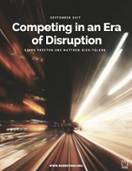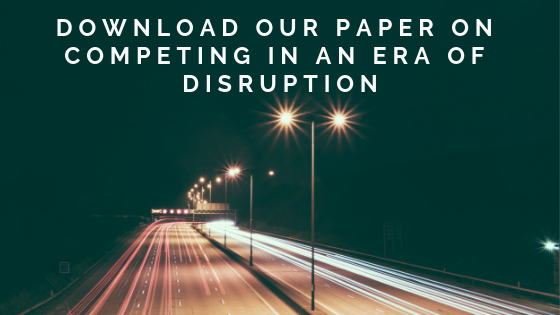Ten Steps to a Collaborative Mindset
How diverse is the community of people that influences your thinking? Do your people have the ability to think and draw conclusions? Can they adapt to changes, and learn quickly? If you can answer positively, you’re likely to have an agile and adaptable workforce, the modern prerequisites for resilience in performance. Maybe you’re already a leader with a collaborative mindset.
Adaptability is an essential trait for all your colleagues as shifting markets and shifting expectations in the workplace bring new challenges every day. The skill-set that delivered someone a promotion last month may be what causes their role to be eliminated next month. Success yesterday is no longer a reliable indicator for tomorrow. Everyone has to focus on the future and their contribution to creating it.
Processes that enable organisational agility - by supporting dynamic change and responding rapidly to environmental stimuli - will provide the key strategic difference between competitors. With windows of opportunity becoming shorter, how quickly can your organisation respond? Equally importantly, how quickly can it execute changes? To help you consider where your company is right now, here’s our top ten questions to consider…
1 Is your structure hierarchical with command and control systems? This can discourage initiative and lead to longer reaction times. It wastes time and energy in ‘managing up’, breeding anxiety and lack of trust amongst employees. By ensuring opportunities for good quality dialogue within your team, you’re able to leverage everybody's life experience to the full.
2 Are your business practices inflexible? Highly optimised systems can be super efficient, but difficult to adapt. The more your assets, skills and processes become specialised, the more change is likely to be incremental and slower. If you’re smart, you’ll recognise the difference in managing the creative, divergent part of business and the convergent, doing part of business.
3 Is your decision-making centralised? If the power to make key decisions is vested with a few individuals at the top, this can deny change, blunt enthusiasm and smother agile and adaptable behaviours. Similarly, would you assess your key meetings as energy sources or energy sinks?
4 Does your organisation have a compelling purpose? The absence of a clear shared purpose may mean your people find it difficult to identify how they can contribute to progress. As for understanding what your company’s source of competitive advantage is... The fastest growing companies have an aspirational, transformative purpose to capture hearts and minds. Critically important, a truly shared purpose or context thrives on participation and not instruction.
5 Do your employees have the right skillset and mindset? Critical-thinking, problem- solving and decision-making are the building blocks that establish a framework to help employees identify changes in their environment quickly and adapt response strategies targeted at producing the right outcomes.
6 Do you embrace grassroots leadership and the organisational agility that comes with it? Companies who support decision-making structures that facilitate the diverse input of a broad community of employees gain access to innovative ideas and alternative approaches that can solve problems and create business opportunities (instead of relying on a few people in leadership positions). Implementing such ideas quicker than your competitors is key to creating competitive advantage.
7 Do you encourage a diversity of approach? If you value conformity and cohesion at the expense of diversity and divergence, this can limit your ability to generate the great ideas that could make your business genuinely adaptable. Without enough experimentation taking place in the business, future winning strategies are unlikely to emerge. And don’t underestimate it’s influence on your ability to attract and retain talent and customers. Not to mention the potential loss of cash reserves. In responding to changing circumstances the business mantra has to be ‘agile and adaptable’ not ‘stuck and slow’.
8 How reliant are you on ownership of assets? In an information-based world the modern successful company places greater value on accessing, renting and sharing - helping them to stay nimble. Rather than ‘owning’ employees, exponential organisations hire external people for simple to complex projects, even mission critical processes - providing speed, functionality and flexibility.
9 Is your use of technology geared to agility and adaptability? Technology continues to shape the future through advances in software and the digitalisation of virtually everything - engagement of customers and employees, learning, information, interfaces enabling involvement, access and control. In terms of being ‘tech savvy’ have you thought about the importance of attracting young people in their 20s/30s to influence the thinking of your business?
10 How far has your business explored the potential for collaboration? As more businesses wake up to the reality of disruptive risk, the smart players are realising that collaboration is a way to mitigate that risk. Think about allocating time to exposure of ideas outside your business that could change your business. Your capacity to collaborate can be your greatest sustainable competition advantage in an age of accelerating change.
So having considered those ten questions, how well placed are you to face the future and what steps do you take next? Whilst this may be a modern challenge, the logic behind the approach required is timeless. “To improve is to change. To perfect is to change often.” said Sir Winston Churchill, or was it Gary Oldman? Even Mahatma Gandhi had an opinion on it: “Adaptability is not imitation. It means power of resistance and assimilation.” Sounds like a man who understood the importance of resilience.
Click on the image to download our paper "Competing in an Era of Disruption"
.png?width=120&height=120&name=RISE%20Logo%20(7).png)
%20(1).png?width=133&height=133&name=Compass%20Coasters%20(87%20x%2087%20cm)%20(1).png)


.png)
-1.png)
